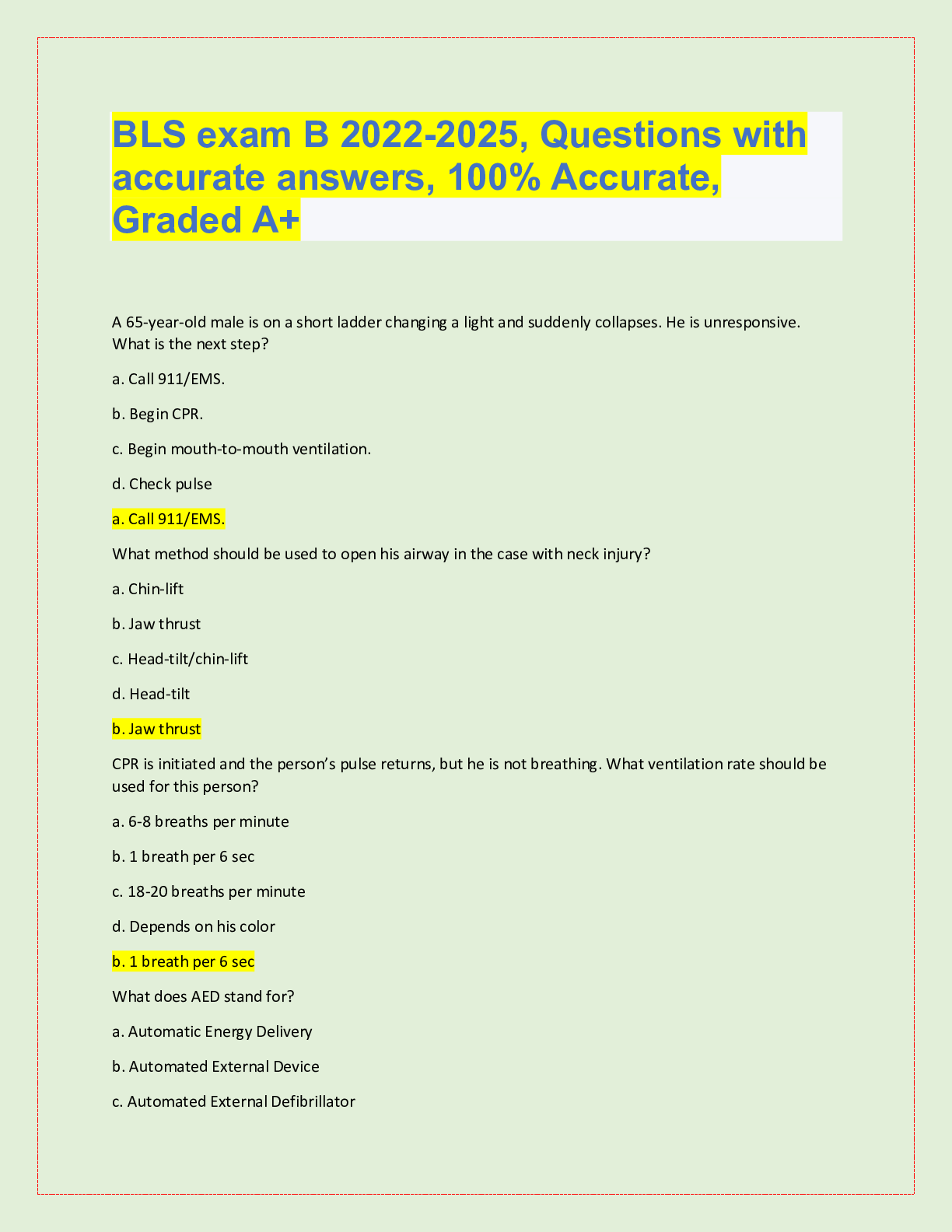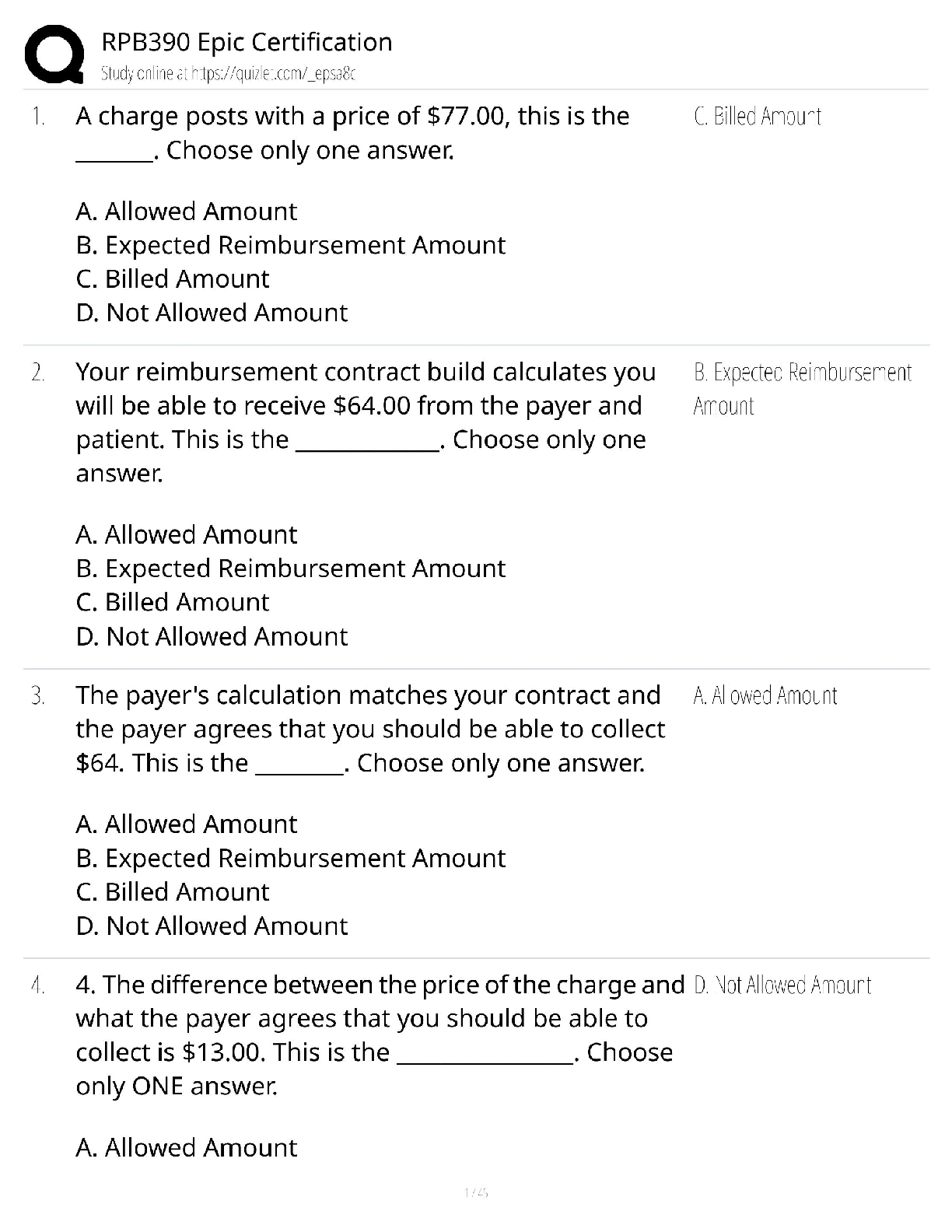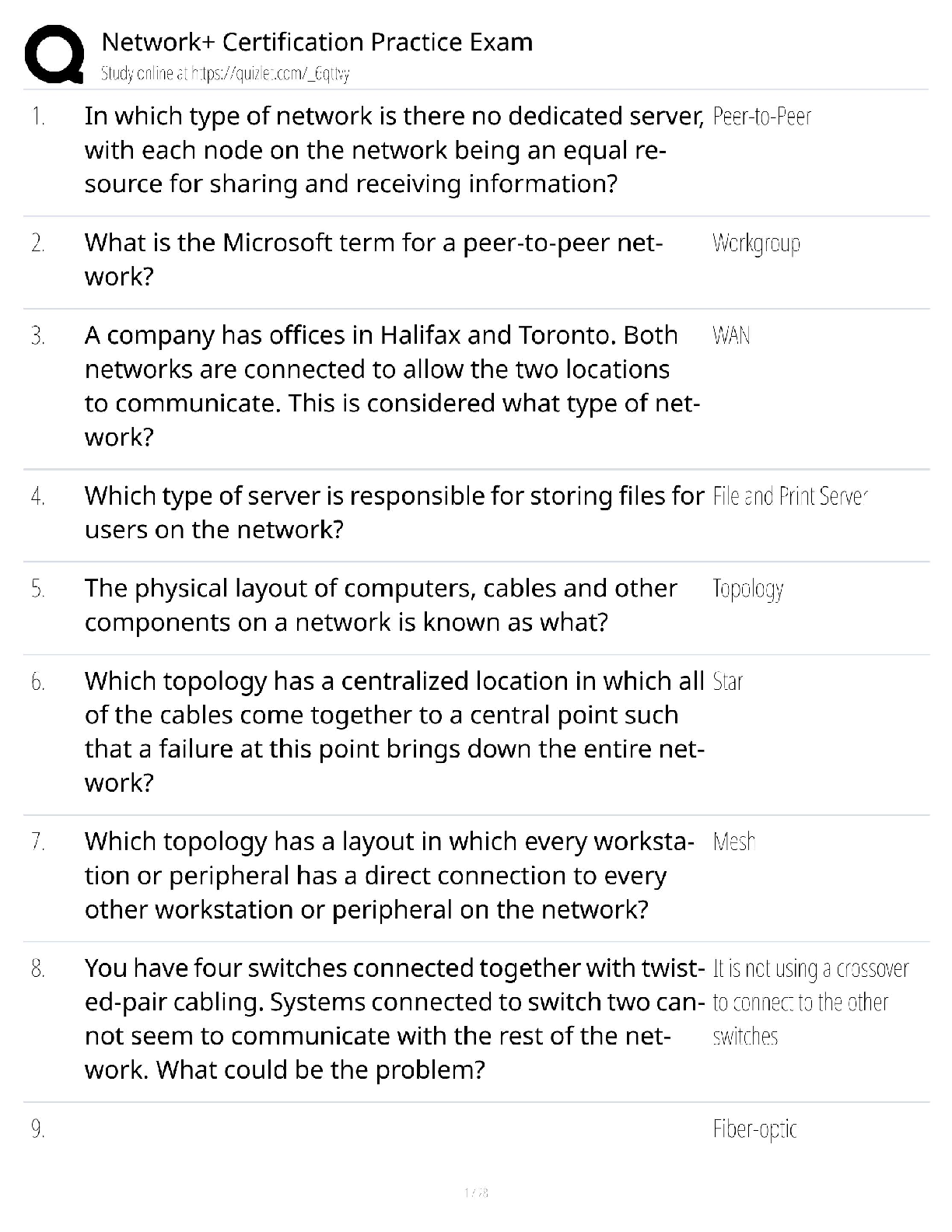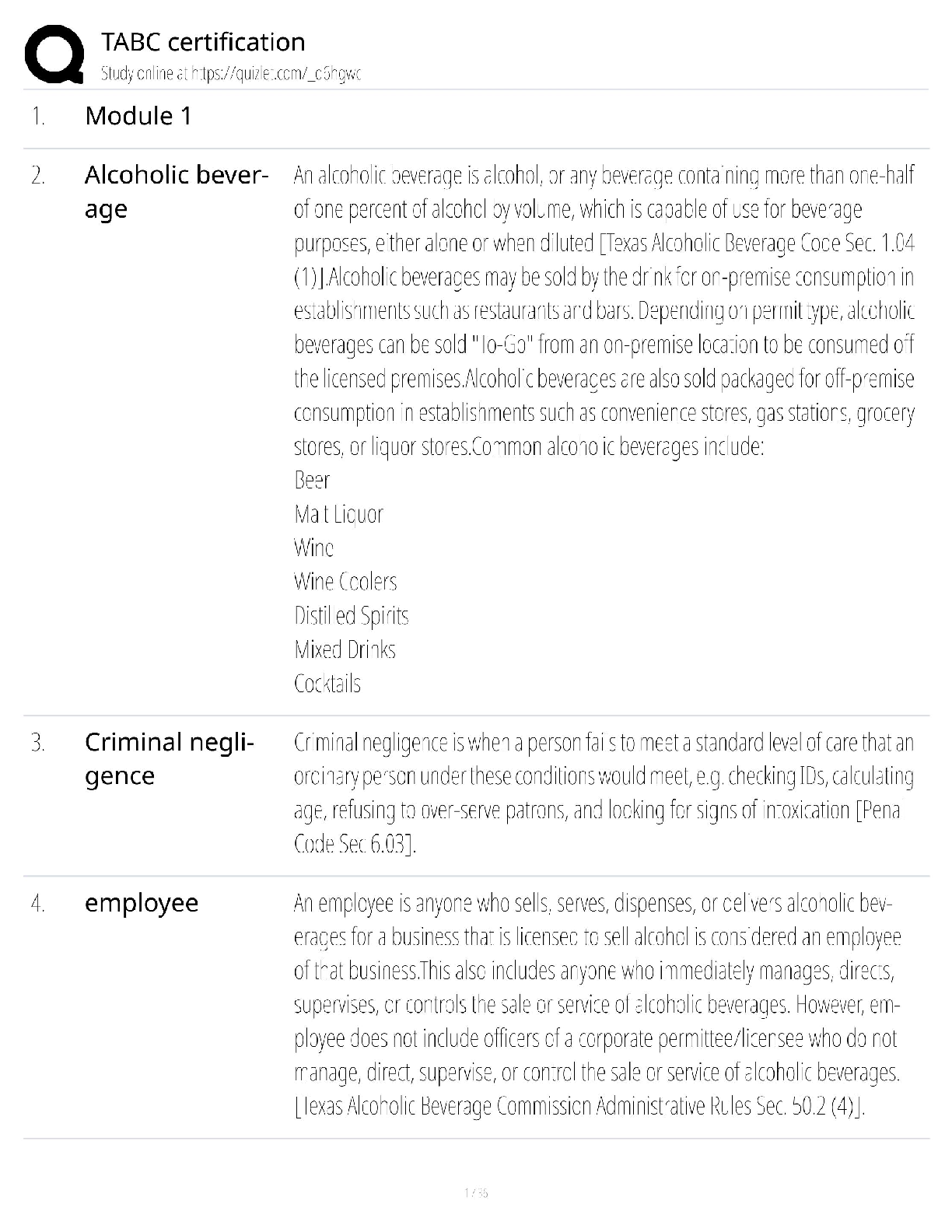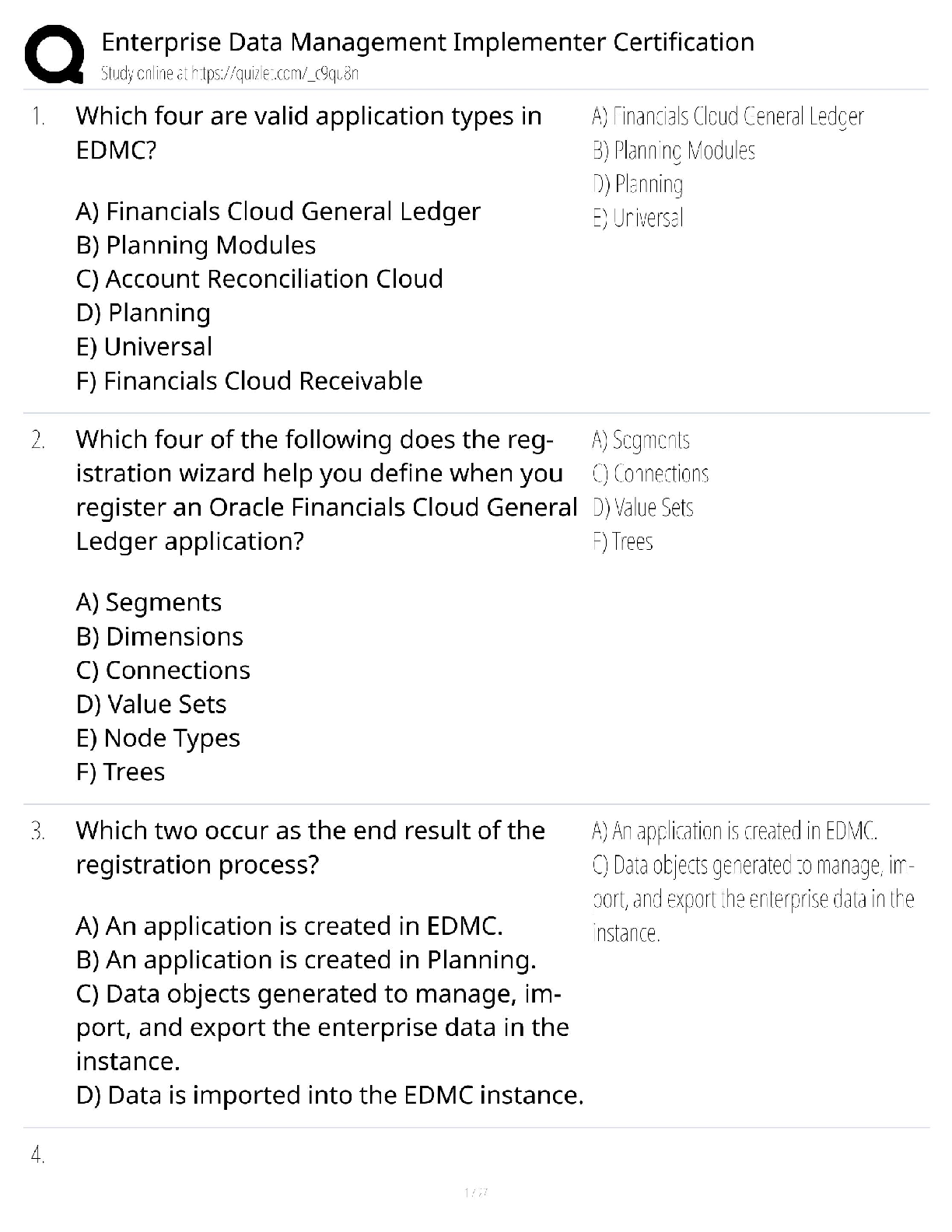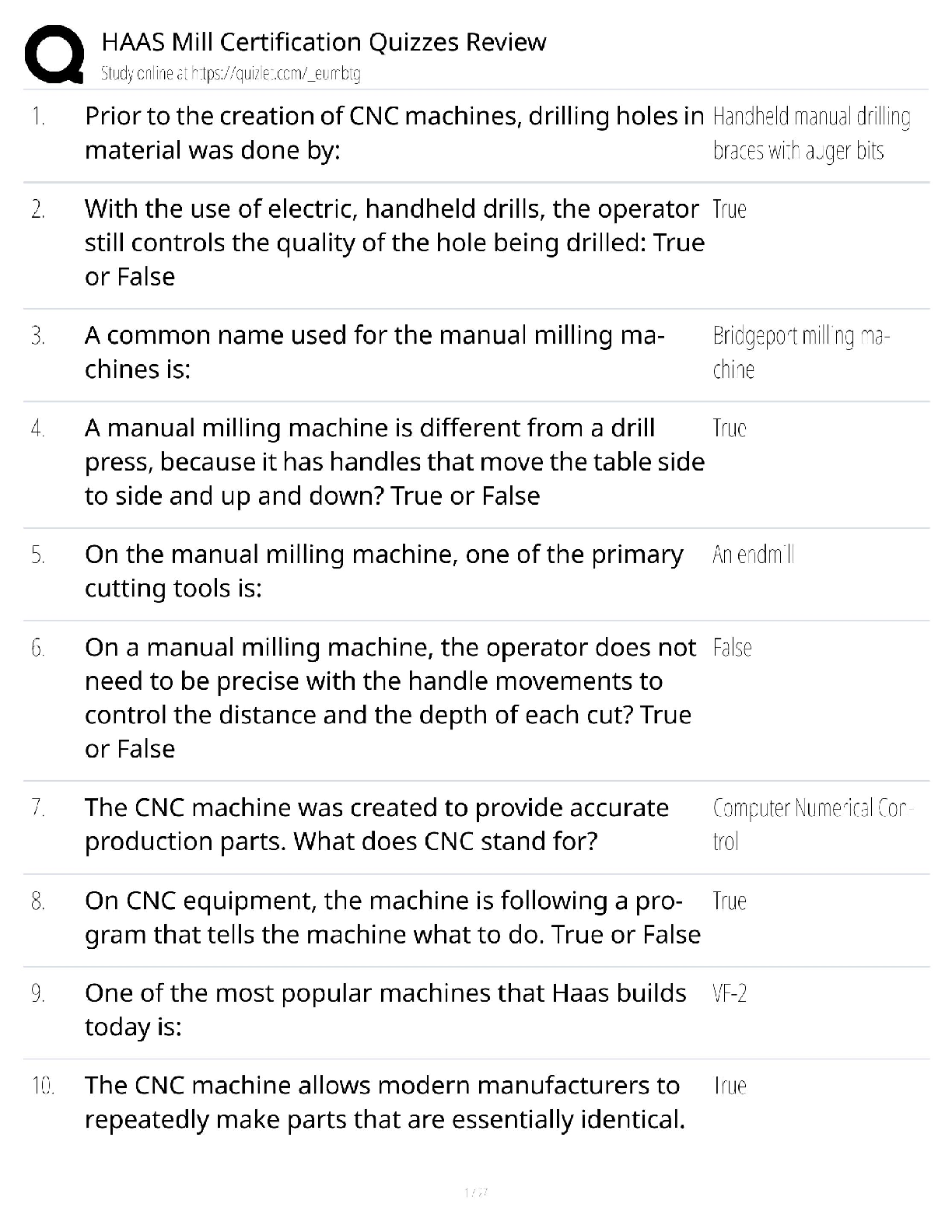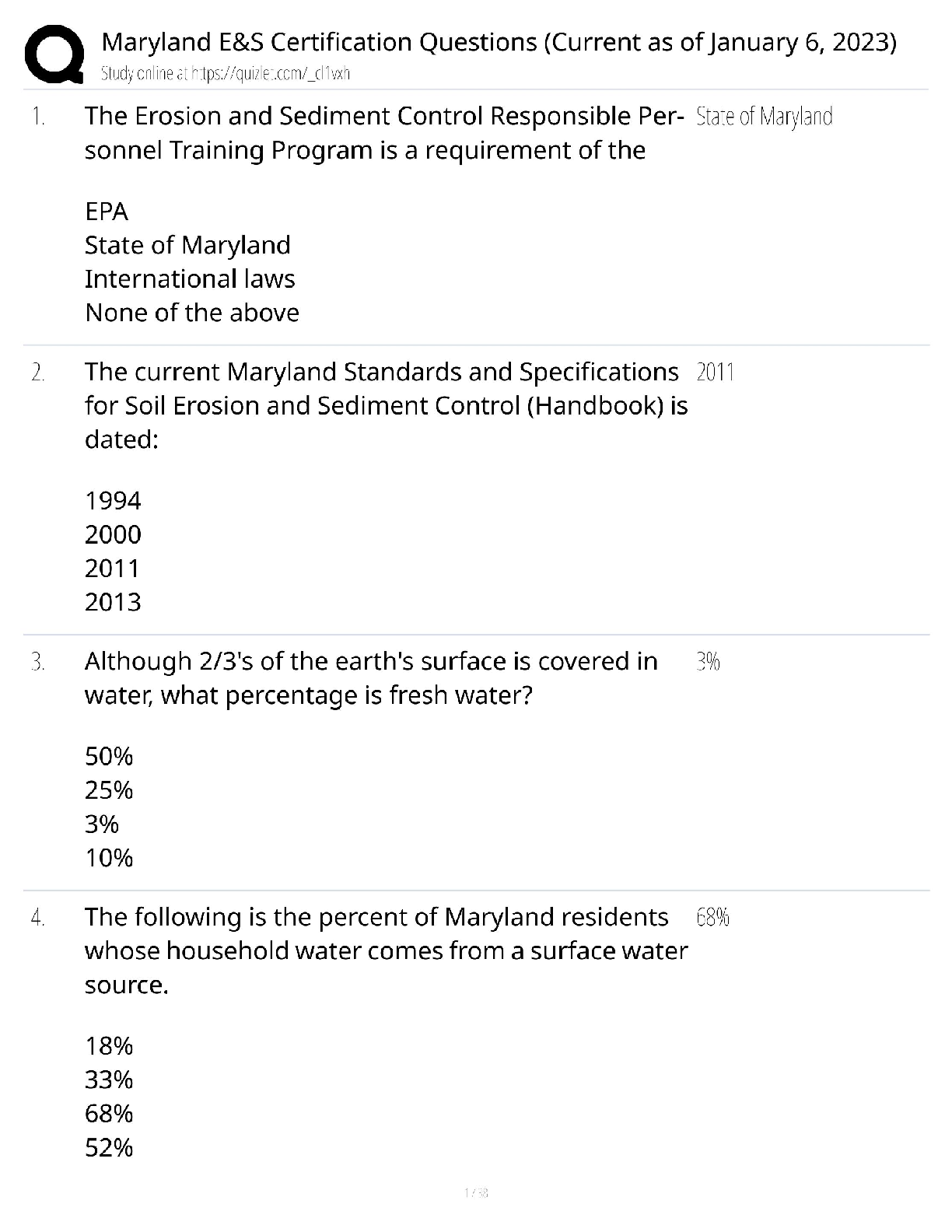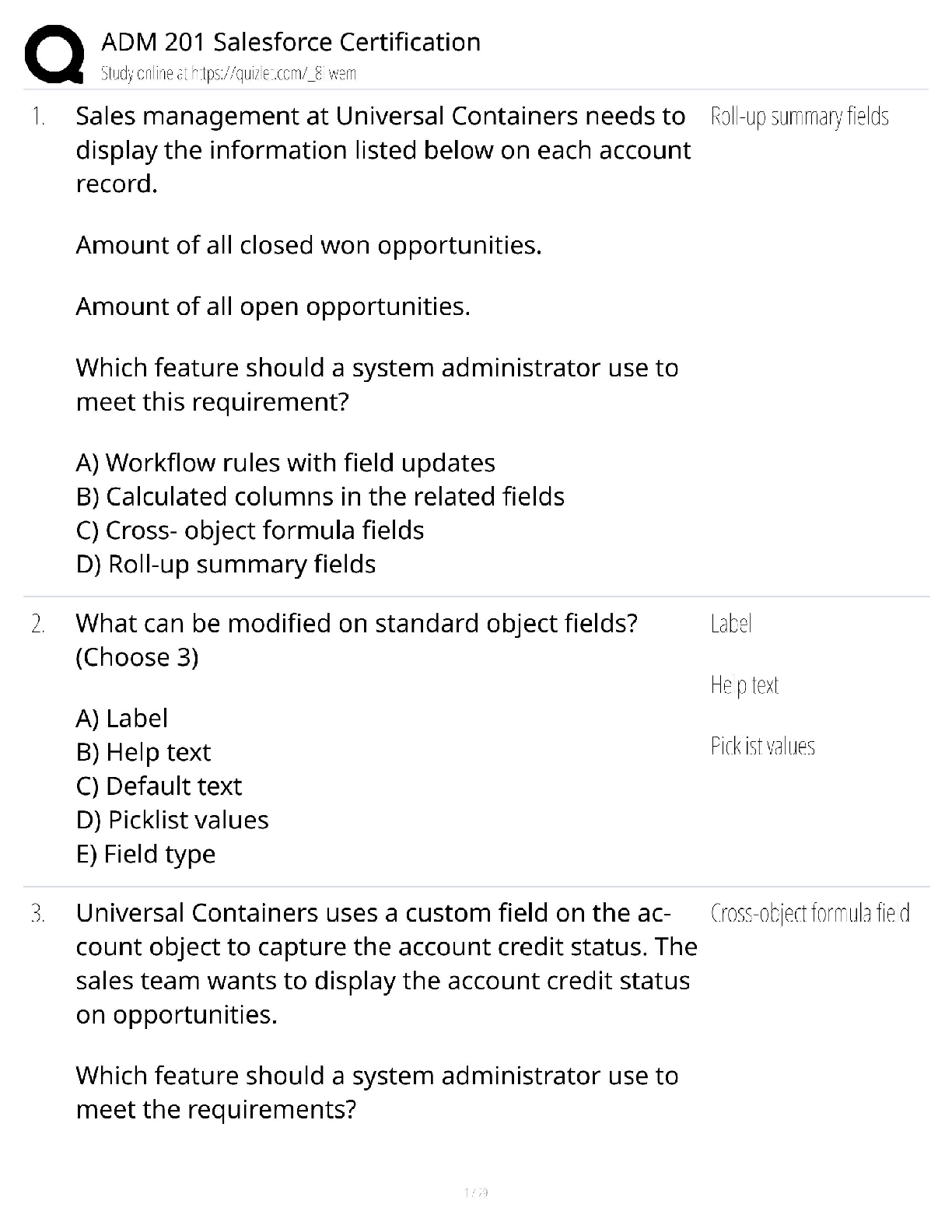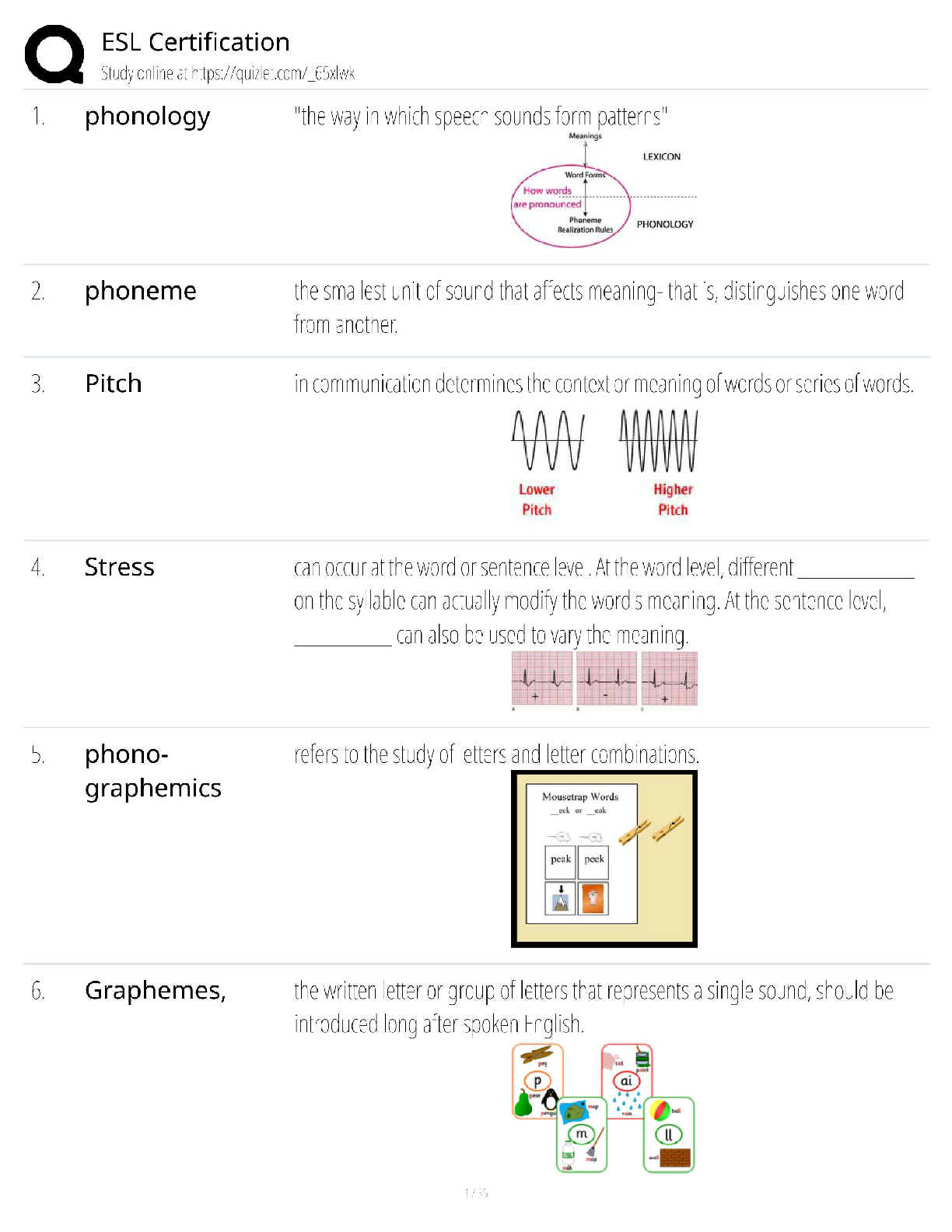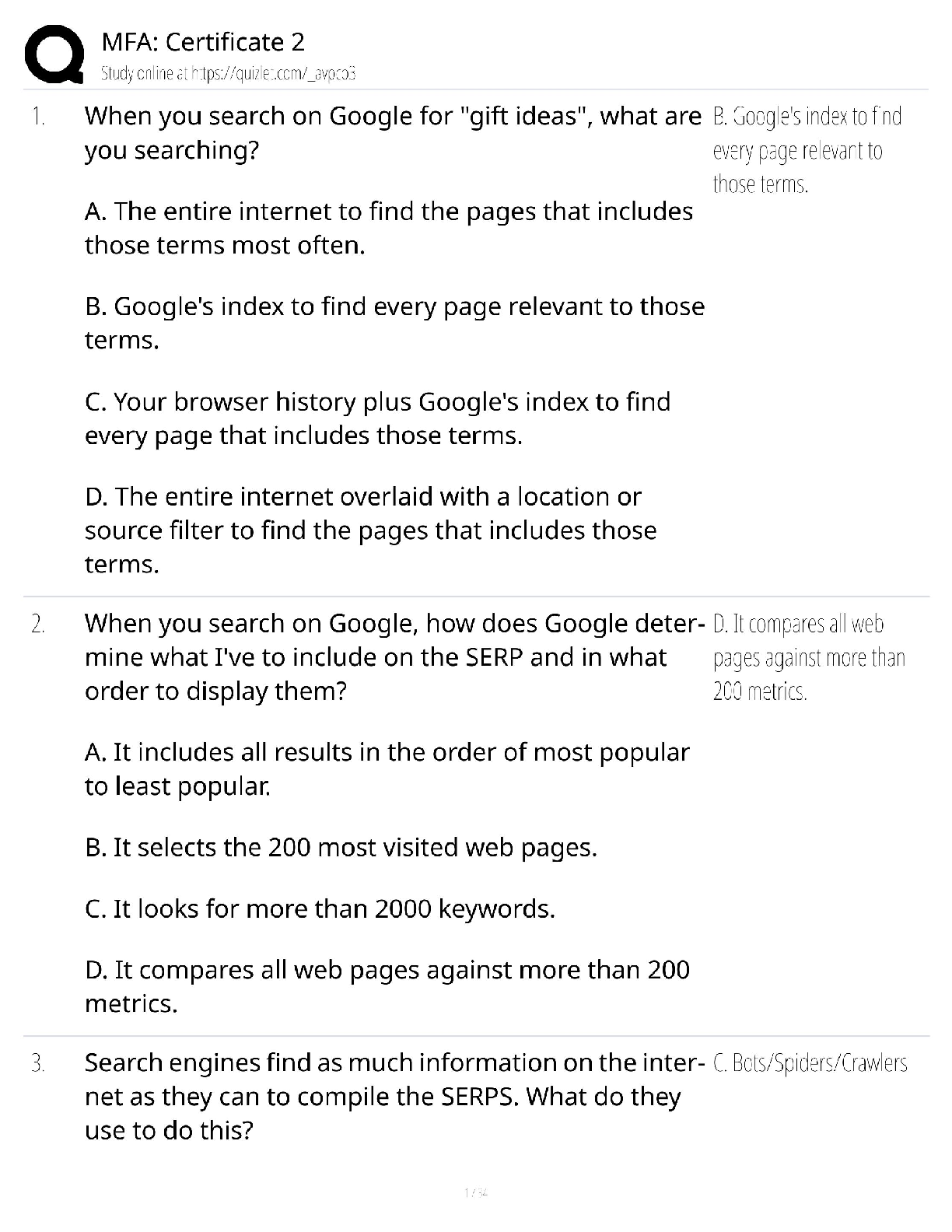*NURSING > QUESTIONS & ANSWERS > NR 509 midterm Questions with accurate answers, 100% Accurate. Rated A. 2022/2023 (All)
NR 509 midterm Questions with accurate answers, 100% Accurate. Rated A. 2022/2023
Document Content and Description Below
NR 509 midterm Questions with accurate answers, 100% Accurate. Rated A. 2022/2023 Cause of saddle numbness and urinary retention - ✔?Cauda equina syndrome Presentation of retinal detachmen ... t - ✔?If sudden visual loss is unilateral and painless, Obtunded - ✔?patient opens the eyes and looks at you but responds slowly and is somewhat confused. Alertness and interest in the environment are decreased. Cranial nerve for lateral gaze - ✔?CN6: Abducens Adult Illnesses - ✔?Medical: Illnesses such as diabetes, hypertension, hepatitis, asthma, and human immunodeficiency virus (HIV); hospitalizations; number and gender of sexual partners; and risk-taking sexual practices ■ Surgical: Dates, indications, and types of operations ■ Obstetric/Gynecologic: Obstetric history, menstrual history, methods of contraception, and sexual function ■ Psychiatric: Illness and time frame, diagnoses, hospitalizations, and treatments Present Illness - ✔?chronologic description of the problems prompting the patient's visit, including the onset of the problem, the setting in which it developed, its manifestations, and any treatments to date.Each problem/symptom needs: (1) location; (2) quality; (3) quantity or severity; (4) timing, including onset, duration, and frequency; (5) the setting in which it occurs; (6) factors that have aggravated -meds, allergies, tobacco use, ETOH and drug use Absence of red reflex - ✔?an opacity of the lens (cataract) or, possibly, the vitreous (or even an artificial eye). Less commonly, a detached retina or, in children, a retinoblastoma may obscure this reflex. S/S of seasonal allergies - ✔?Itching, watery eyes, sneezing, ear congestion, postnasal drainage Presentation of optic neuritis - ✔?Enlarged blind spot, vision loss in 1 eye, loss of color vision, hole in center of vision, trouble seeing to the side, eye pain pityriasis rosea - ✔?Multiple round to oval scaling violaceous plaques on abdomen and back Acromion - ✔?tip of shoulder What to do for + finding on physical exam, but - workup - ✔?continue using test, but less lab and diagnostics Cause of falsely high BP - ✔?-too small of a BP cuff - if the brachial artery is below heart level - loose cuff - bladder that balloons outside the cuff Check for nystagmus - ✔?-involuntary jerking movement of the eyes with quick and slow components. - It is named for the direction of the quick component - seen in cerebellar disease and vestibular disorders and in internuclear ophthalmoplegia Jaundice - ✔?yellow sclera how do get a patient to open up when upset - ✔?effective reassurance is simply identifying and acknowledging the patient's feelings. -Partnering -Summarizing -Transitions - Empowering the pt s/s of degenerative pain - ✔?-Slowly progressive, with temporary exacerbations after periods of overuse -usually insidious - flexion and deviation deformities How otosclerosis presents with Weber and Rinne test - ✔?- Weber: Sound lateralizes to impaired ear. Room noise not well heard, so detection of vibrations improves - Rinne: BC longer than or equal to AC. While air conduction through the external or middle ear is impaired, vibrations through bone bypass the problem to reach the cochlea. Cherry angiomas - ✔?Benign Interpreting visual acuity test - ✔?Vision of 20/200 means that at 20 feet the patient can read print that a person with normal vision could read at 200 feet. The larger the second number, the worse the vision. "20/40 corrected" means the patient could read the 20/40 line with glasses (a correction). Sequence of the interview - ✔?Preparation. Then, Greeting the patient and establishing rapport. Establishing the agenda for the interview. Inviting the patient's story. Exploring the patient's perspective. Identifying and responding to emotional cues. Expand-ing and clarifying the patient's story. Generating and testing diagnostic hypotheses. Sharing the treatment plan. Closing the interview and the visit. Taking time for self-reflection. Patient consent - ✔?you need consent to carry out a visit with someone in the room with them. Health History - ✔?● Identifying data and source of the history; reliability ● Chief complaint(s) ● Present illness ● Past history ● Family history ● Personal and social history ● Review of systems Rotator cuff injury - ✔?Atrophy of the supraspinatus and infraspinatus with increased prominence of scapular spine can appear within 2 to 3 weeks of a rotator cuff tear; infraspinatus atrophy has a positive likelihood ratio (LR) of 2 for rotator cuff disease. prioritizing patient complaints - ✔?Problem list - Most active and serious problems first - then, problems that need future observation and attention Condylar joints - ✔?Knee & TMJ -Movement of two articulating surfaces not dissociable Acute RA - ✔?Tender, painful, stiff joints in RA, usually with symmetric involvement on both sides of the body. The distal interphalangeal (DIP), metacarpophalangeal (MCP), and wrist joints are the most frequently affected. Note the fusiform or spindle-shaped swelling of the PIP joints in acute disease. Chronic RA - ✔?swelling and thickening of the MCP and PIP joints. Range of motion becomes limited, and fingers may deviate toward the ulnar side. The interosseous muscles atrophy. The fingers may show "swan neck" deformities (hyperextension of the PIP joints with fixed flexion of the distal interphalangeal [DIP] joints). Less common is a boutonnière deformity (persistent flexion of the PIP joint with hyperextension of the DIP joint). Rheumatoid nodules are seen in the acute or the chronic stage. subjective data - ✔?- Symptoms - What pt tells you -goes under ROS sources of joint pain - ✔?-If age <60 years, consider repetitive strain or overuse syndromes like tendinitis or bursitis, crystalline arthritis (gout; crystalline pyrophosphate deposition disease [CPPD]) (males), rheumatoid arthritis (RA), psoriatic arthritis and reactive (Reiter) arthritis (in inflammatory bowel disease [IBD]), and infectious arthritis from gonorrhea, Lyme disease, or viral or bacterial infections. - If age >60 years, look for OA, gout and pseudogout, polymyalgia rheumatica (PMR), osteoporotic fracture, and septic bacterial arthritis. - congenital, inflammatory or infectious, immunologic, neoplastic, metabolic, nutritional, degenerative, vascular, traumatic, and toxic? CN 1-6 - ✔?1) Olfactory- smell 2)Optic- visual acuity with eye chart & pupil response 3)Oculomotor- conjugate gaze with EOM 4)Trochlear- conjugate gaze with EOM 5) Trigeminal- palpate masseter & touch face and have pt identify where 6) Abducens- Conjugate gaze with EOM CN 7-12 - ✔?7)Facial- Blow cheeks out, smile, frown, pucker lips 8)Vestibulocochlear (Acoustic)- Whisper test 9) Glossopharyngeal- Gag reflex 10)Vagus- say "ahhh". soft palate and uvula rise symmetrically 11) Accessory- shrug shoulders 12) Hypoglossal- Stick out tongue and move left to right epistaxis causes - ✔?nosebleed - cause: trauma, inflammation, drying and crusting of the mucosa, tumors and foreign bodies Vesicular lung sounds - ✔?soft and low pitched. They are heard throughout inspiration, continue without pause through expiration, and then fade away about one [Show More]
Last updated: 3 years ago
Preview 1 out of 8 pages

Buy this document to get the full access instantly
Instant Download Access after purchase
Buy NowInstant download
We Accept:

Also available in bundle (1)
Click Below to Access Bundle(s)

NR 509 BUNDLE. QUESTIONS AND ANSWERS, 2022/2023 RATED A. 2022/2023 predictor papers. 100% verified.
examinable NR 509 exam bundle. latest updates. NR 509 BUNDLE. QUESTIONS AND ANSWERS, 2022/2023 RATED A. 2022/2023 predictor papers. 100% verified.
By Topmark 3 years ago
$20
6
Reviews( 0 )
$10.00
Can't find what you want? Try our AI powered Search
Document information
Connected school, study & course
About the document
Uploaded On
Sep 24, 2022
Number of pages
8
Written in
All
Additional information
This document has been written for:
Uploaded
Sep 24, 2022
Downloads
0
Views
168

